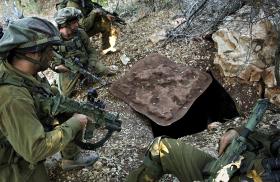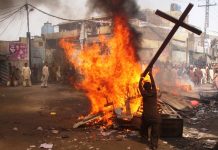Hezbollah Infiltrates Israel (Part 2): Potential Responses
Nadav Pollak/Washington Institute/March 22/2023
Hezbollah Infiltrates Israel (Part 1): Another Step Toward Changing the Rules of the Game
Matthew Levitt/The Washington Institute/March 22/2023
«حزب الله» يتسلل إلى إسرائيل (الجزء الأول): خطوة أخرى نحو تغيير قواعد اللعبة
ماثيو ليفيت/معهد واشنطن/22 آذار/2023
على الرغم من أن حادث تسلل عميل إرهابي من لبنان إلى إسرائيل يمثل تصعيداً كبيراً، إلا أنه يُعدّ أيضاً استمراراً لنمط من السلوك قائماً منذ فترة طويلة يهدف إلى إعادة تشكيل التفاهمات غير الرسمية القائمة منذ حرب عام 2006.
في وقت سابق من هذا الشهر، تسلل عميل إرهابي من لبنان إلى إسرائيل باختراقه “الخط الأزرق” الذي رسمته الأمم المتحدة ومتجنباً الدوريات الحدودية وأنظمة الكشف عن بُعد. وبعد أن قطع مسافة ستين كيلومتراً جنوباً باتجاه مفترق “مجيدو”، قام بزرع عبوة ناسفة متطورة من النوع الذي يستخدمه «حزب الله» عادةً، مما أدى إلى إصابة مواطن عربي إسرائيلي بجروح خطيرة عند تفجيرها. ثم استقل سيارة عابرة بينما كانت قوات الأمن تشنّ عملية مطاردة. وعندما أوقفت السلطات السيارة بالقرب من بلدة يعراه الحدودية، خرج السائق منها لكن الإرهابي رفض الإذعان. وحيث كان متسلحاً بحزام ناسف وأسلحة أخرى، سرعان ما قُتل رمياً بالرصاص.
ولم تنشر السلطات الإسرائيلية بعد النتائج التي توصلت إليها بشأن هوية المشتبه فيه، إلا أن الجيش وجهاز مخابرات الـ “شاباك” مقتنعان بأنه كان ينفذ عملية من قبل «حزب الله»، في حين أعلنت جماعة غير معروفة سابقاً تطلق على نفسها اسم “قوات الجليل – الذئاب المنفردة” مسؤوليتها عن الهجوم عبر منصة “تلغرام”، كما نشرت صوراً لمواقع إسرائيلية مختلفة ولمسؤولين إسرائيليين مرفقة بعبارة “الأهداف التالية”. ومع ذلك، يبدو أن السلطات تجد في هذا الادعاء دعاية تهدف إلى تحويل الأنظار عن دور «حزب الله». ففي النهاية، هناك القليل الذي يمرّ عبر الحدود دون موافقة الحزب، كما أن نوع الجهاز المستخدم في الهجوم مرتبط بـ «حزب الله» وليس بالجماعات الفلسطينية.
ولعل الأهم من ذلك أن هذه الحادثة هي الأخيرة ضمن سلسلة طويلة من مساعي «حزب الله» المتزايدة لتغيير التفاهمات والخطوط الحمراء التي تحكم صراعه مع إسرائيل. ويركز الجزء الأول من هذا المرصد السياسي على هذه المساعي لإعادة صياغة قواعد اللعبة، بينما سيعمد الجزء الثاني إلى تقييم حسابات إسرائيل وخيارات ردها.
تحريك الأهداف
عندما نشر «حزب الله» الجزء الأكبر من قواته للدفاع عن نظام الأسد خلال الحرب الأهلية في سوريا، كان يسعى لكسب الوقت فيما يتعلق بقتاله ضد إسرائيل. وكان ذلك يعني التركيز على مشاريع طويلة الأجل من شأنها تحسين قدرته على مهاجمة إسرائيل في وقت لاحق، كالاستثمار في أنفاق الهجوم عبر الحدود واستيراد صواريخ دقيقة التوجيه وتطويرها. وأمضى «حزب الله» سنوات طويلة وأنفق مبالغ كبيرة على المشروع الأول، حيث قام ببناء الأنفاق التي كشفتها إسرائيل في كانون الأول/ديسمبر 2018 ودمرتها على مدار الأشهر القليلة التي أعقبت ذلك. ولا يزال المشروع الثاني يشكل اليوم تهديداً، على الرغم من الجهود التي بذلتها إسرائيل لمنع عمليات نقل الصواريخ عبر سوريا والكشف علناً عن منشآت الصواريخ العاملة في المناطق الحضرية المكتظة بالسكان في لبنان.
وفي الآونة الأخيرة، ومع عودة الغالبية العظمى من قوات «حزب الله» إلى لبنان، كان الحزب يطمح إلى استعادة مصداقيته بصفته “المقاومة” – وإن كان ذلك بطريقة تقلل من احتمالية حدوث رد عسكري إسرائيلي واسع النطاق. وفي الفترة التي سبقت حرب عام 2006 أخطأ الأمين العام للحزب حسن نصر الله في تقدير ردّ إسرائيل على اختطاف جنودها عبر الحدود. ومع ذلك، فوفقاً لمحللين إسرائيليين، يعتقد الآن أن بإمكانه التنبؤ بسلوك العدو بمزيد من الدقة، الأمر الذي دفعه إلى زيادة حدة لهجته والموافقة على سلسلة من الإجراءات الأكثر عدائية على مدى السنوات الثلاث الماضية.
سابقاً، كان التفاهم غير الخطي يتمثل بعدم قيام «حزب الله» بمهاجمة إسرائيل طالما كانت عمليات القوات الإسرائيلية تقتصر على استهداف شحنات أسلحته في سوريا – ولن يتم تجاوز الخطوط الحمراء للحزب إلا إذا قامت إسرائيل بقصف أهداف على الأراضي اللبنانية أو بقتل عناصر تابعة له في أي بلد. على سبيل المثال، في 1 أيلول/سبتمبر 2019، أطلق «حزب الله» صواريخ مضادة للدبابات على سيارة إسعاف عسكرية إسرائيلية كانت تمرّ بين المجتمعات الحدودية في أفيفيم وييرون، في ردّ واضح على هجومين إسرائيليين، تمثل الأول بقصف جوي أدّى إلى مقتل عنصرين من «حزب الله» في سوريا، والثاني بهجوم طائرة بدون طيار في بيروت استهدف خلاطاً للوقود يُستخدم لصناعة الصواريخ دقيقة التوجيه.
لكن في الوقت نفسه، بدأ «حزب الله» باتخاذ خطوات لتغيير قواعد اللعبة. فبعد غارة الطائرة المسيّرة في بيروت عام 2019، تعهد نصر الله باستهداف طائرات الاستطلاع الإسرائيلية في سماء لبنان – سواء كانت قد شاركت في الهجمات أم لا. وبحلول شباط/فبراير 2022 كان يتفاخر بأن قدرات «حزب الله» المضادة للطيران أرغمت إسرائيل على الحد بشكل كبير من تحليق طائراتها المسيّرة فوق جنوب لبنان والامتناع عن إطلاق مثل تلك الطائرات فوق وادي البقاع طوال أشهر. ويبدو أن بعض هذه المزاعم حظيت بتأكيد قائد سلاح الجو الإسرائيلي، عميكام نوركين، في نيسان/أبريل، الذي اعترف بالدفاعات الجوية العدائية لـ «حزب الله»، وأشار إلى أن الحزب كاد أن يُسقط طائرة إسرائيلية مسيّرة في عام 2021، ووصف ما نجم عن ذلك من تقليص رحلات التحليق الجوي لجمع المعلومات الاستخباراتية، وخلص إلى أنه “لم يعد لدى إسرائيل الحرية الكاملة في التصرف في لبنان”.
وبالمثل، خلال الخطاب نفسه الذي ألقاه نصر الله في آب/أغسطس 2019 وهدد فيه بإسقاط الطائرات الإسرائيلية المسيّرة، حذر الجنود الإسرائيليين المتمركزين على طول الحدود للبقاء على أهبة الاستعداد بقوله “بدءاً من اليوم، قفوا على رجل ونصف وانتظروا ردّنا”. وفي تموز/يوليو 2020، أفادت التقارير أن الجيش أحبط هجوماً لعناصر مسلحين من «حزب الله» دخلوا الأراضي الإسرائيلية.
ولكن سرعان ما أدى انفجار مرفأ بيروت في آب/أغسطس 2020 إلى صرف انتباه «حزب الله» عن التوترات المتصاعدة (على الأقل فيما يتخطى زيادة نقاط المراقبة التابعة له على طول “الخط الأزرق”)، لكن خطاب التهديد عاد مجدداً في عام 2021. فعندما أرسلت إيران شحنة من الوقود إلى لبنان في آب/أغسطس، حذر نصر الله علناً من أن أي هجوم على الناقلة سيعتبر هجوماً على الأراضي اللبنانية وبالتالي سيؤدي إلى قيام «حزب الله» بالرد على ذلك – وهو تصريح محفوف بالمخاطر وسط تصعيد متبادل بين إسرائيل وإيران ضد مصالح الشحن الخاصة ببعضهما البعض.
وفي تموز/يوليو 2022، رفع نصر الله سقف التحدي بتهديده استهداف منصات الغاز الطبيعي البحرية الإسرائيلية إذا باشرت إسرائيل باستخراج الغاز من حقل كاريش قبل التوصل إلى اتفاق حدودي بحري مع لبنان. وبعد ذلك بوقت قصير، أُسقطت ثلاث طائرات مسيّرة تابعة لـ «حزب الله» كانت في طريقها إلى منصة كاريش. وعلى الرغم من أن التحقيقات اللاحقة أشارت إلى أنها لم تكون مسلحة، إلا أن الرسالة كانت واضحة؛ فقد حذر نصر الله من أن هذه الطائرات المسيّرة هي “مجرد البداية” وتعهد بخوض حرب بشأن مسـألة الغاز إذا لزم الأمر. وتابع «حزب الله» ذلك بـ فيديو دعائي يظهر لقطات بطائرة بدون طيار لحقل كاريش يتم استهدافه بسلاح ما على ما يبدو.
وكان استعداد نصر الله للمخاطرة بمواجهة إسرائيل مدفوعاً جزئياً بالضغوط الاقتصادية والسياسية المحلية – ولا شك أنه استمتع بفرصة إخبار الشعب اللبناني بأن أسلحة «حزب الله» قد وفرت حماية لنقل النفط من إيران وأمّنت التوصل إلى اتفاق أفضل حول الحدود البحرية وحقل الغاز. ومع ذلك، بدا أنه يعتقد أيضاً أنه من غير المرجح أن ترد إسرائيل على تهديداته بطريقة جادة نظراً لترسانة «حزب الله» من الصواريخ الدقيقة وأنظمة الدفاع الجوي الكبيرة، بل قدّر أن إسرائيل ستقلص رحلات طائراتها المسيّرة وستمتنع عن مهاجمة شحنة النفط الإيرانية، وستؤجل استخراج الغاز إلى أن يتم إبرام الاتفاقية البحرية – وفي كل حالة كان تقييمه صحيحاً. إلا أن السؤال الذي يتداوله محللو الاستخبارات الإسرائيليون الآن هو ما إذا كانت هذه السلسلة من التقييمات الدقيقة قد شجعت نصر الله على القيام بمخاطر أكبر.
سوء التقدير نتيجته التصعيد
في 6 آذار/مارس، أي قبل أسبوع من تفجير مجيدو، ادّعى نصر الله أن «حزب الله» قد قيّد حرية إسرائيل في التصرف لمهاجمة الحزب، من خلال استعادة عملية “توازن الردع”. وفي إشارة إلى الاضطرابات السياسية المستمرة في البلاد، أعلن أن إسرائيل على شفا حرب أهلية، وخلص إلى أن “جميع المؤشرات تشير إلى نهاية” الدولة اليهودية.
وبالإضافة إلى التفجير، شهد هذا الشهر تقارير متزايدة عن مضايقات عبر الحدود ضد الإسرائيليين، مثل توجيه أشعة الليزر على السائقين والمنازل، وإطلاق انفجارات مدوية على الحدود اللبنانية، وصب مياه الصرف الصحي باتجاه البلدات الإسرائيلية. كما عطّل «حزب الله» الجهود الإسرائيلية لتعزيز الحاجز الأمني في عدد من المواقع على طول “الخط الأزرق”.
وتشير هذه العدائية المتسللة – إلى جانب إحساس نصرالله بردع إسرائيل وإضعاف موقفها العسكري – إلى أن «حزب الله» سيستمر في محاولة تحريك الأهداف. ومن الجانب الإسرائيلي، تعهد وزير الدفاع، يوآف غالانت، بأن “المسؤول عن الهجوم سيندم على فعلته. سنجد المكان والزمان المناسبين وسنضربهم”. ويمكن أن يتأثر القرار بشأن هذا الرد ليس بالاعتبارات الأمنية فحسب، بل بتشكيلة الحكومة المتشددة ورغبتها في تخفيف حدة الأزمة الداخلية في إسرائيل أيضاً. بعبارة أخرى، توفر عوامل متعددة على كلا الجانبين فرصاً كبيرة لسوء التقدير والتصعيد غير المقصود.
*ماثيو ليفيت هو “زميل فرومر ويكسلر” ومدير “برنامج راينهارد للاستخبارات ومكافحة الإرهاب” في معهد واشنطن، ومصمم أداة الخريطة التفاعلية التابعة للمعهد، والتي تغطي أنشطة «حزب الله» في جميع أنحاء العالم.
https://www.washingtoninstitute.org/ar/policy-analysis/hzb-allh-ytsll-aly-asrayyl-aljz-alawl-khtwt-akhry-nhw-tghyyr-qwad-allbt
Hezbollah Infiltrates Israel (Part 1): Another Step Toward Changing the Rules of the Game
Matthew Levitt/The Washington Institute/March 22/2023
Despite representing a significant escalation, the incident also continues a longstanding pattern of behavior aimed at rewriting the informal understandings established since the 2006 war.
Earlier this month, a terrorist operative infiltrated Israel from Lebanon, crossing the UN-demarcated Blue Line and evading border patrols and remote detection systems. After traveling sixty kilometers south to the Megiddo junction, he planted a sophisticated improvised explosive device of a type typically used by Hezbollah, which seriously wounded an Arab Israeli citizen upon detonating. He then hitched a ride from a passing car while security forces led a manhunt. When authorities stopped the car near the border town of Yaara, the driver exited the vehicle but the terrorist refused. Armed with an explosive belt and other weapons, he was soon shot dead.
Authorities have yet to release their findings on the suspect’s identity, but the military and the Israel Security Agency believe he was operating on Hezbollah’s behalf. The attack was claimed on Telegram by a previously unknown group calling itself “The Galilee Forces—the Lone Wolves,” which also posted pictures of various Israeli locations and officials with the caption “the next targets.” Yet authorities appear to view this claim as propaganda intended to distract from Hezbollah’s role—after all, little transpires across the border without the group’s consent, and the device used in the attack is a type associated with Hezbollah, not Palestinian groups.
Perhaps more important, the incident is just the latest in a long series of escalating Hezbollah efforts to change the understandings and red lines that govern its conflict with Israel. Part 1 of this PolicyWatch focuses on these efforts to rewrite the rules of the game; Part 2 assesses Israel’s calculus and response options.
Moving the Goalposts
When Hezbollah deployed the bulk of its forces to defend the Assad regime during Syria’s civil war, it sought to buy time regarding its fight with Israel. This meant focusing on long-term projects that would improve its ability to attack Israel at a later date, such as investing in cross-border attack tunnels and importing and developing precision-guided missiles. Hezbollah spent years and significant funds on the first project, building tunnels that Israel exposed in December 2018 and destroyed over the next few months. The second project continues to pose a threat today, despite Israel’s efforts to interdict missile-related transfers via Syria and publicly reveal missile facilities operating in densely populated urban areas of Lebanon.
More recently, with the vast majority of its forces back in Lebanon, Hezbollah has been eager to reestablish its “resistance” credentials—albeit in a way that minimizes the likelihood of a full-scale Israeli military retaliation. In the lead-up to the 2006 war, Secretary-General Hassan Nasrallah famously miscalculated how Israel would respond to the cross-border abduction of its soldiers. According to Israeli analysts, however, he now believes he can predict the enemy’s behavior more accurately, leading him to sharpen his rhetoric and approve a series of increasingly aggressive actions over the past three years.
Previously, the unwritten understanding was that Hezbollah would not attack Israel so long as Israeli forces limited themselves to targeting its weapons shipments in Syria—the group’s red lines would only be crossed if Israel struck targets on Lebanese soil or killed the group’s personnel in any country. For example, on September 1, 2019, Hezbollah fired antitank missiles at an Israeli military ambulance driving between the border communities of Avivim and Yiron, an apparent response to a pair of Israeli attacks: an airstrike that killed two Hezbollah operatives in Syria, and a drone strike in Beirut that targeted a propellant mixer used in the manufacture of precision-guided missiles.
At the same time, however, Hezbollah began taking steps to change the rules of the game. After the 2019 Beirut drone strike, Nasrallah vowed to shoot Israeli surveillance drones out of Lebanon’s skies—whether or not they were involved in attacks. By February 2022, he was boasting that Hezbollah’s antiaircraft capabilities had forced Israel to drastically reduce its drone flights over south Lebanon and refrain from any such flights over the Beqa Valley for months. Israeli Air Force chief Amikam Norkin seemed to confirm some of these claims that April—he acknowledged Hezbollah’s aggressive air defenses, noted that the group had nearly shot down an Israeli drone in 2021, and described the resultant dampening of intelligence collection overflights, concluding that “Israel no longer has full freedom of action over Lebanon.”
Similarly, during the same August 2019 speech in which he threatened to down Israeli drones, Nasrallah warned Israeli soldiers stationed along the border to be on guard: “Starting today, you should stand on a leg and a half and wait for us.” In July 2020, the military reportedly thwarted an attack by armed Hezbollah operatives who had crossed into Israeli territory.
The August 2020 Beirut port explosion soon distracted Hezbollah from escalating tensions (at least beyond increasing its observation posts along the Blue Line), but the threatening rhetoric picked up again in 2021. When Iran sent a shipment of oil to Lebanon that August, Nasrallah publicly warned that any attack on the vessel would be considered an attack on Lebanese territory and therefore trigger a Hezbollah response—a risky statement in the midst of Israel and Iran’s tit-for-tat escalation against each other’s shipping interests.
In July 2022, Nasrallah further upped the stakes by threatening to target Israel’s offshore natural gas platforms if it began extracting from the Karish field before reaching a maritime border deal with Lebanon. Soon thereafter, three Hezbollah drones were shot down en route to the Karish platform. Although subsequent investigation indicated they were not armed, the message was clear—Nasrallah warned that these drones were “only the beginning” and pledged to go to war over the gas issue if necessary. Hezbollah followed up with a propaganda video featuring drone footage of the Karish field apparently being targeted with a weapon.
Nasrallah’s willingness to risk conflict with Israel was partly driven by domestic economic and political pressures—he no doubt relished the opportunity to tell the Lebanese people that Hezbollah’s weapons had protected the oil delivery from Iran and secured a better deal on the maritime border and gas field. Yet he also seemed to believe that Israel was unlikely to respond in a serious way to his threats given Hezbollah’s enlarged precision missile arsenal and air defense systems. Instead, he assessed that Israel would scale down its drone flights, refrain from attacking Iran’s oil shipment, and delay gas extraction until the maritime agreement was concluded—and in each case his assessment was correct. The question that Israeli intelligence analysts are now debating is whether this string of accurate assessments has emboldened Nasrallah to take even greater risks.
Current Risk of Miscalculation, Escalation
On March 6, a week before the Megiddo bombing, Nasrallah claimed that Hezbollah had restrained Israel’s freedom of action to attack the group by reestablishing a “balance of deterrence.” Referring to the country’s ongoing political turmoil, he declared that Israel is on the verge of civil war and concluded that “all indications point to the end” of the Jewish state.
In addition to the bombing, this month has seen increased reports of cross-border harassment against Israelis, such as aiming laser beams at drivers and homes, setting off loud explosions on the Lebanese frontier, and pouring sewage toward Israeli towns. Hezbollah has also disrupted Israeli efforts to reinforce the security barrier in several spots along the Blue Line.
This creeping aggressiveness—coupled with Nasrallah’s sense of having deterred Israel and weakened its military posture—indicate that Hezbollah will continue trying to move the goalposts. For Israel’s part, Defense Minister Yoav Gallant has pledged, “Whoever is responsible for the attack will regret it. We’ll find the right place and time and we’ll hit them.” The decisionmaking on this response could be affected not only by security considerations, but also by the government’s hardline composition and its desire to tamp down Israel’s domestic crisis. In other words, multiple factors on both sides provide ample opportunities for miscalculation and unintended escalation.
*Matthew Levitt is the Fromer-Wexler Fellow at The Washington Institute, director of its Reinhard Program on Counterterrorism and Intelligence, and creator of its interactive map tool covering Hezbollah’s worldwide activity.
Hezbollah Infiltrates Israel (Part 2): Potential Responses
Nadav Pollak/Washington Institute/March 22/2023
Israel should act quickly on multiple fronts to show Hezbollah that it will not shy away from escalation, especially if the organization continues to test it.
Two things became clear after the perpetrator of last week’s Megiddo terrorist attack was killed: first, a much bigger attack was avoided (as discussed later in this article), and second, Hezbollah probably knew what was about to happen and may have approved the operation, if not executed it firsthand. The latter realization is quite alarming because it means that Hezbollah’s leaders were willing to take a risk of real escalation with Israel, even if they perceived that risk to be low. As discussed in Part 1 of this PolicyWatch, the attack is another glaring sign that Hezbollah has changed the rules of the game. Israeli decisionmakers must therefore re-clarify their redlines—with force if necessary.
Hezbollah’s Role in the Attack
So far, not many details have been published regarding the attack or the perpetrator identity’s. The Israel Defense Forces (IDF) and Israel Security Agency have released some information on the weapon used (a claymore-like explosive) and the terrorist’s general route, but nothing on his identity. Yet most fingers are pointing in Hezbollah’s direction given the group’s strong security control over south Lebanon, especially along the border with Israel.
True, Hezbollah is not the only actor that might be involved in such a cross-border attack. For example, Hamas has entrenched itself in the Lebanese arena in recent years, building military capabilities and recruiting local fighters to its ranks. Another possible culprit is Iran, which is constantly trying to find more ways to execute attacks against Israel from the north. But even if Hamas, Iran, or other actors were involved, they would not have been able to execute such an operation without Hezbollah’s approval.
Indeed, the circumstances of the Megiddo attack reminded many in Israel of another terrorist operation that Hezbollah executed in 2002, when it sent two Palestinian terrorists across the northern border to kill Israelis near the Matzuva kibbutz. At the time, the group likely hoped that using Palestinian operatives might obscure its involvement in the attack. Today, however, Hezbollah can hardly have expected to cover its tracks given that the terrorist crossed its heavily guarded border while carrying advanced explosives, and used a ladder to get over Israel’s security barrier—the same tactic used by the 2002 attackers.
Israel’s Response Options
Hezbollah’s risk analysis was no doubt shaped by what is going on inside Israel today, from growing social rifts to a heavily protested government plan for judicial overhaul. The group’s leader, Hassan Nasrallah, is considered to be a close watcher and decent analyst of Israeli politics, so he may have believed that now was a good time to move the goalposts and raise a challenge on the security front.
For Israel, maintaining calm on the northern border has been a top priority in recent years. Officials did not want a flare-up with Hezbollah, so they limited many of the IDF’s activities in Lebanon, especially against Hezbollah targets. Even when the group showed that it was willing to test Israeli red lines—most notably last July when it sent drones toward the Karish gas field, a strategically important site—Israel downed the aircraft but did not take further steps that might escalate the situation (e.g., targeting Hezbollah’s drone bases in Lebanon).
Today, however, Israel cannot stop at pointing fingers and issuing harsh statements. The Megiddo attack might have caused much more damage given the additional explosives and other weapons the terrorist was carrying; even the lone device detonated at Megiddo could have easily been used to destroy a larger target such as a bus. Moreover, Hezbollah’s apparent effort to test (or shift) Jerusalem’s redlines on a dangerous frontier needs to be answered. If Nasrallah has misjudged Israel, then it is incumbent on Jerusalem to make this clear, ideally via the following main steps:
Declassify as much intelligence as possible without risking sensitive sources, publishing all evidence regarding Hezbollah’s involvement in the attack and identifying all individuals who had a hand in planning and executing it. At the very least, this would signal to these individuals that they are on Israel’s radar and may be attacked at the first possible opportunity, regardless of their affiliations.
Reach out to any possible interlocutor with Hezbollah, conveying the message that further attempts to change the rules of the game are unacceptable and will be met with overwhelming force. This message should be delivered to the Lebanese government as well, since the IDF response to continued attacks against Israel would damage the Lebanese state, not just Hezbollah. Israel can pass this message via the various French or regional officials who are in touch with Beirut and elements of Hezbollah.
Last and most important, prepare for escalation. Unfortunately, the days of keeping the north quiet at any cost have passed, especially if Hezbollah no longer believes Israel is willing to respond forcefully. The last time the organization perceived Israel to be weak was in 2006, and its resultant cross-border operations (e.g., kidnapping Israeli soldiers) led to a war that proved to be devastating, mostly to Lebanon. If Hezbollah tries to challenge Israel again, Israel should be ready to take strong action such as targeting the group’s commanders and headquarters in Lebanon—even if this runs the risk of intense fire exchanges or war. Relevant preparations for this option should include increased monitoring of Hezbollah officials—overtly and covertly—and perhaps even the transfer of some military units to the north. Hezbollah needs to know that Israel is no longer shying away from conflict, since this may be the only way of forcing the group to return to the old, accepted rules of the game and step down from the precipice of a war that it does not appear to want either.
Yes, Israel is currently focused on how to deal with an assortment of weighty problems at home. But it is precisely because of this domestic instability that signaling adversaries like Hezbollah is so important. By sending the right message, Israel can show that it is still a formidable force and should not be tested during this time.
*Nadav Pollak is a lecturer at Reichman University and a former Diane and Guilford Glazer Foundation Fellow at The Washington Institute.





















